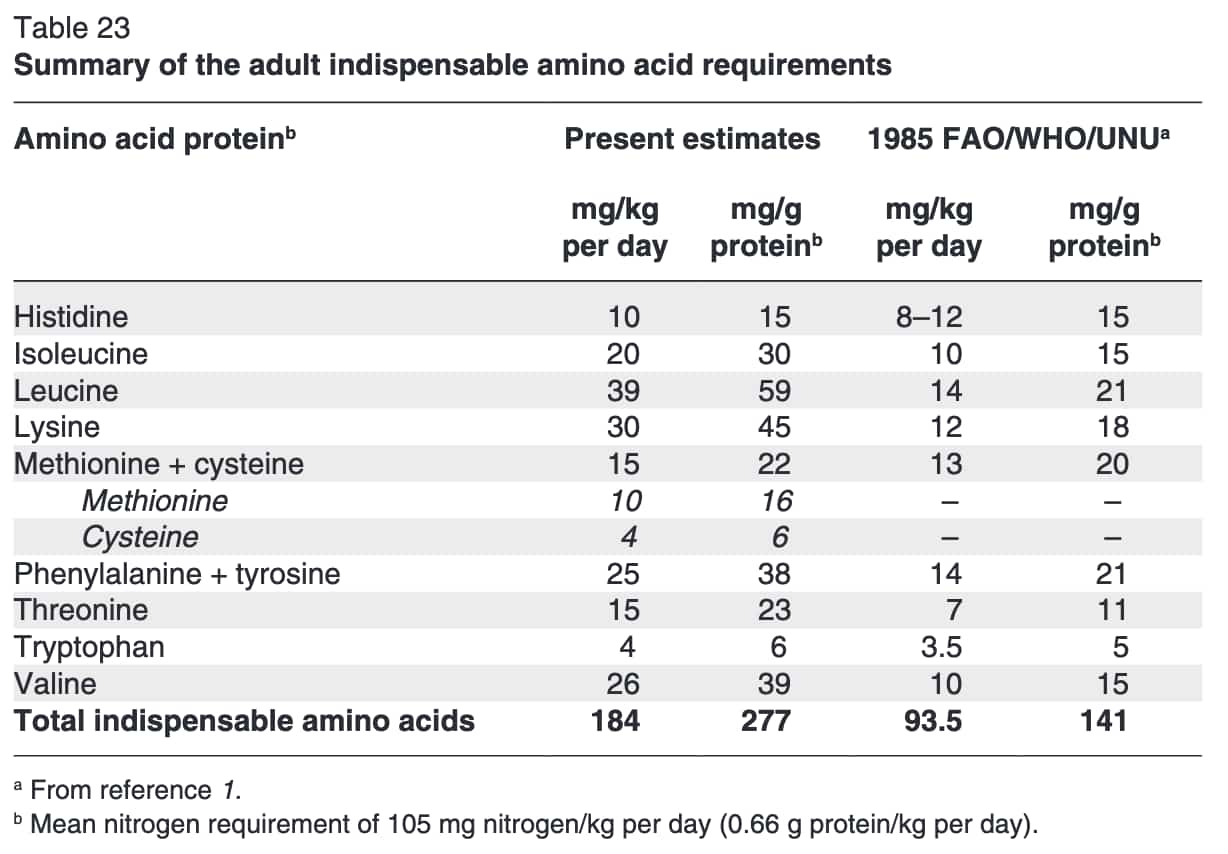16 Complete Protein Pairings with Yellow Mustard
Summary:
- Yellow mustard contains a moderate amount of protein - about 0.6 grams per tbsp.
- However, yellow mustard provides only 8 of the 9 essential amino acids sufficiently - it is a little low on tryptophan.[1]
- Yellow mustard pairs well with breadfruit seeds, chia seeds, oregano, crimini mushroom or sesame seeds to create a complete protein profile. [2] More yellow mustard pairings and detailed analysis below.
A complete protein is a protein source that "contains adequate proportions of the nine essential amino acids" that our body can not produce on its own.
We analyzed the amino acid composition of yellow mustard, and found both vegan and vegetarian pairings with yellow mustard that creates a complete protein profile. Read on to discover new combinations of foods to enjoy!
Details on how we calculate complete protein profiles.
Amount of Protein in Yellow Mustard
A decent source of supplementary protein, a single tablespoon of yellow mustard contains 0.6 grams of protein, or about 1% of recommended daily values. [1]
To get the adequate amount of protein with yellow mustard alone, you will need 89 tablespoons of yellow mustard (1340 grams) for an average female, or 107 tablespoons of yellow mustard for males. [4] That's about 802 calories, and a lot of yellow mustard! Supplementing yellow mustard with food higher in protein is a good idea.
Full nutritional profile for yellow mustard
USDA Source: Mustard, prepared, yellow
Macronutrients in 1 tbsp (15g) of yellow mustard:
| % of RDV | Amount | ||
| Calories |
|
0.5% | 9 kCal |
| Carbohydrates |
|
0% | - |
| Total fat |
|
0.8% | 0.5 grams |
| Protein |
|
1.1% | 0.6 grams |
Essential Amino Acids in Yellow Mustard
Proportionally, yellow mustard does contain abundant amounts of 8 out of the nine essential amino acids. However, yellow mustard is a little short on tryptophan.[1]
To have adequate amounts of all nine essential amino acids with yellow mustard alone, you will have to eat 193 tablespoons of yellow mustard (2889 grams) for an average person. [2]
That's about 116% more yellow mustard to compensate for the lack of tryptophan, compared to the protein requirement alone.
The amount of each essential amino acid in 1 tbsp (15g) of yellow mustard:
| Amino Acid | % of RDV [2] | Amount [1] |
Complete / Adequate |
|
| Protein |
|
1.1% | 0.561g | |
| Histidine |
|
2.8% | 0.018g | |
| Isoleucine |
|
2.5% | 0.022g | |
| Leucine |
|
2.3% | 0.044g | |
| Lysine |
|
2.3% | 0.04g | |
| Methionine |
|
1.3% | 0.011g | |
| Phenylalanine |
|
1.6% | 0.024g | |
| Threonine |
|
2.8% | 0.025g | |
| Tryptophan |
|
0.5% | 0.001g | |
| Valine |
|
2.6% | 0.028g |
More Complete Protein with Yellow Mustard
- Breadfruit Seeds
- Chia Seeds
- Oregano
- Crimini Mushroom
- Sesame Seeds
- Hedge Mustard Seeds
- Thyme
- Jackfruit
- Sweet Potatoes
- Maitake Mushroom
- Pumpkin Seeds
- Tumeric
- Persimmon
- Pili Nut
- Papaya
- Ginger
- Portabella Mushroom
- Barley
- Flaxseeds
- Spirulina
- Mango
- Cashews
- Mint
- Rosemary
- Grapes
- Sunflower Seeds
- Parsley
Vegan 1. Breadfruit Seeds and Yellow Mustard


A reasonable source of supplementary protein, breadfruit seed is high in tryptophan, which is complementary to yellow mustard.
A ratio of 10 tablespoons of yellow mustard (150g) and 1.1 tablespoons of breadfruit seeds (11g) creates a complete protein profile. The entire range to create a complete protein are ratios of 1:0.07 to 1:0 for yellow mustard to breadfruit seed by weight.
Full nutritional profile for breadfruit seeds
USDA Source: Seeds, breadnut tree seeds, dried
| Amino Acid | % of RDV [2] | Amount [5] |
Complete / Adequate |
|
| Protein |
|
13.2% | 6.6g | |
| Histidine |
|
30.7% | 0.19g | |
| Isoleucine |
|
31.8% | 0.27g | |
| Leucine |
|
28.7% | 0.54g | |
| Lysine |
|
25.6% | 0.44g | |
| Methionine |
|
13.9% | 0.12g | |
| Phenylalanine |
|
19.3% | 0.29g | |
| Threonine |
|
32% | 0.29g | |
| Tryptophan |
|
15.3% | 0.04g | |
| Valine |
|
34.9% | 0.38g |
Vegan 2. Chia Seeds and Yellow Mustard
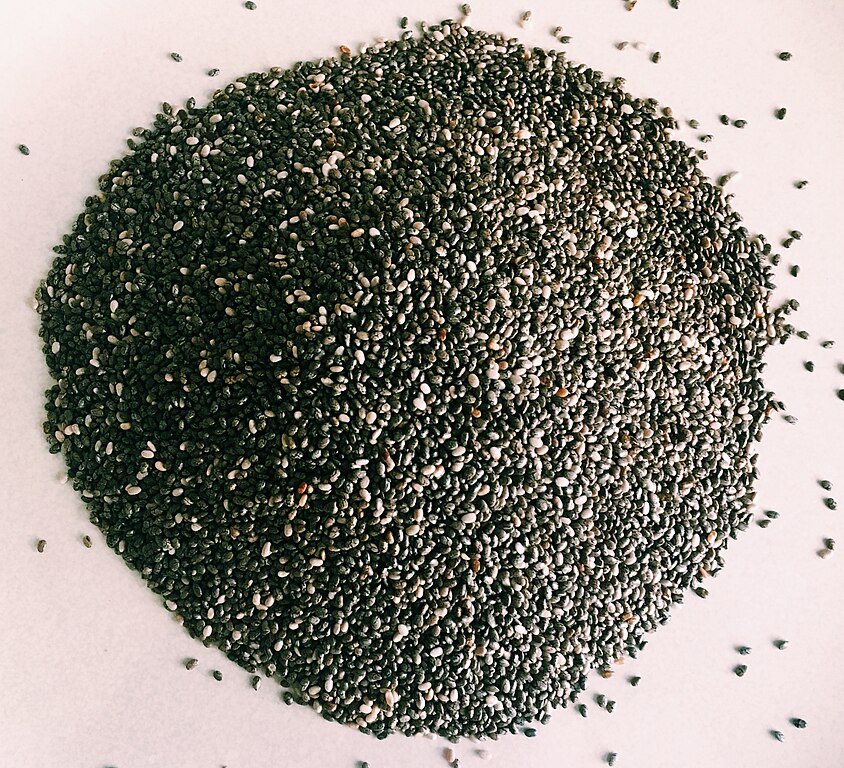

Chia seed is a reasonable source of supplementary protein, and is high in tryptophan, complementing the profile of yellow mustard.
For example, 10 tablespoons of yellow mustard (150g) and 0.2 ounce of chia seeds (6g) make a complete amino acids profile. The entire range to create a complete protein are ratios of 1:0.04 to 1:4 for yellow mustard to chia seed by weight.
Full nutritional profile for chia seeds
USDA Source: Seeds, chia seeds, dried
| Amino Acid | % of RDV [2] | Amount [6] |
Complete / Adequate |
|
| Protein |
|
13.2% | 6.6g | |
| Histidine |
|
33.4% | 0.21g | |
| Isoleucine |
|
31.1% | 0.27g | |
| Leucine |
|
27.6% | 0.52g | |
| Lysine |
|
26.6% | 0.45g | |
| Methionine |
|
17.4% | 0.15g | |
| Phenylalanine |
|
20.3% | 0.3g | |
| Threonine |
|
32.6% | 0.29g | |
| Tryptophan |
|
15.3% | 0.04g | |
| Valine |
|
31.6% | 0.34g |
Vegan 3. Oregano and Yellow Mustard


A reasonable source of supplementary protein, oregano is high in tryptophan, which is complementary to yellow mustard.
A ratio of 10 tablespoons of yellow mustard (150g) and 0.3 cup of oregano (14g) creates a complete protein profile. The entire range to create a complete protein are ratios of 1:0.09 to 1:0.13 for yellow mustard to oregano by weight.
Full nutritional profile for oregano
USDA Source: Spices, oregano, dried
| Amino Acid | % of RDV [2] | Amount [7] |
Complete / Adequate |
|
| Protein |
|
13.7% | 6.8g | |
| Histidine |
|
31.4% | 0.2g | |
| Isoleucine |
|
32.5% | 0.28g | |
| Leucine |
|
28.8% | 0.54g | |
| Lysine |
|
27.1% | 0.46g | |
| Methionine |
|
15.3% | 0.13g | |
| Phenylalanine |
|
20.3% | 0.3g | |
| Threonine |
|
32.7% | 0.29g | |
| Tryptophan |
|
15.9% | 0.04g | |
| Valine |
|
33.6% | 0.36g |
Vegan 4. Crimini Mushroom and Yellow Mustard


Crimini mushroom is a reasonable source of supplementary protein, and is high in tryptophan, complementing the profile of yellow mustard.
For example, 10 tablespoons of yellow mustard (150g) and 0.6 cup of crimini mushroom (50g) make a complete amino acids profile. The entire range to create a complete protein are ratios of 1:0.33 to 1:33 for yellow mustard to crimini mushroom by weight.
Full nutritional profile for crimini mushroom
USDA Source: Mushrooms, brown, italian, or crimini, raw
| Amino Acid | % of RDV [2] | Amount [8] |
Complete / Adequate |
|
| Protein |
|
13.7% | 6.9g | |
| Histidine |
|
33.6% | 0.21g | |
| Isoleucine |
|
31.2% | 0.27g | |
| Leucine |
|
27.2% | 0.51g | |
| Lysine |
|
30.5% | 0.52g | |
| Methionine |
|
16% | 0.14g | |
| Phenylalanine |
|
19.4% | 0.29g | |
| Threonine |
|
34.1% | 0.31g | |
| Tryptophan |
|
15.9% | 0.04g | |
| Valine |
|
31.5% | 0.34g |
Vegan 5. Sesame Seeds and Yellow Mustard


A reasonable source of supplementary protein, sesame seed is high in tryptophan, which is complementary to yellow mustard.
A ratio of 10 tablespoons of yellow mustard (150g) and 0.8 tablespoon of sesame seeds (8g) creates a complete protein profile. The entire range to create a complete protein are ratios of 1:0.05 to 1:0 for yellow mustard to sesame seed by weight.
Full nutritional profile for sesame seeds
USDA Source: Seeds, sesame seeds, whole, roasted and toasted
| Amino Acid | % of RDV [2] | Amount [9] |
Complete / Adequate |
|
| Protein |
|
13.8% | 6.9g | |
| Histidine |
|
34.3% | 0.22g | |
| Isoleucine |
|
31.9% | 0.27g | |
| Leucine |
|
28.4% | 0.54g | |
| Lysine |
|
25.6% | 0.44g | |
| Methionine |
|
18.2% | 0.16g | |
| Phenylalanine |
|
20.8% | 0.31g | |
| Threonine |
|
33.7% | 0.3g | |
| Tryptophan |
|
16% | 0.04g | |
| Valine |
|
32.9% | 0.35g |
Vegan 6. Hedge Mustard Seeds and Yellow Mustard


Hedge mustard seed is a reasonable source of supplementary protein, and is high in tryptophan, complementing the profile of yellow mustard.
For example, 10 tablespoons of yellow mustard (150g) and 2.3 tablespoons of hedge mustard seeds (11g) make a complete amino acids profile. The entire range to create a complete protein are ratios of 1:0.07 to 1:7 for yellow mustard to hedge mustard seed by weight.
Full nutritional profile for hedge mustard seeds
USDA Source: Seeds, sisymbrium sp. seeds, whole, dried
| Amino Acid | % of RDV [2] | Amount [10] |
Complete / Adequate |
|
| Protein |
|
13.8% | 6.9g | |
| Histidine |
|
33.8% | 0.21g | |
| Isoleucine |
|
33.4% | 0.29g | |
| Leucine |
|
30.1% | 0.57g | |
| Lysine |
|
28.1% | 0.48g | |
| Methionine |
|
17.1% | 0.15g | |
| Phenylalanine |
|
20.3% | 0.3g | |
| Threonine |
|
35.9% | 0.32g | |
| Tryptophan |
|
16% | 0.04g | |
| Valine |
|
33.1% | 0.36g |
Vegan 7. Thyme and Yellow Mustard


A reasonable source of supplementary protein, thyme is high in tryptophan, which is complementary to yellow mustard.
A ratio of 10 tablespoons of yellow mustard (150g) and 0.7 cup of thyme (25g) creates a complete protein profile. The entire range to create a complete protein are ratios of 1:0.17 to 1:0.06 for yellow mustard to thyme by weight.
Full nutritional profile for thyme
USDA Source: Thyme, fresh
| Amino Acid | % of RDV [2] | Amount [11] |
Complete / Adequate |
|
| Protein |
|
14% | 7g | |
| Histidine |
|
28.3% | 0.18g | |
| Isoleucine |
|
33.8% | 0.29g | |
| Leucine |
|
26.7% | 0.5g | |
| Lysine |
|
25% | 0.43g | |
| Methionine |
|
13.3% | 0.11g | |
| Phenylalanine |
|
16.2% | 0.24g | |
| Threonine |
|
32.2% | 0.29g | |
| Tryptophan |
|
16.3% | 0.04g | |
| Valine |
|
33.4% | 0.36g |
Vegan 8. Jackfruit and Yellow Mustard


Jackfruit is low in protein, and is high in tryptophan, complementing the profile of yellow mustard.
For example, 10 tablespoons of yellow mustard (150g) and 0.5 cup of jackfruit (86g) make a complete amino acids profile. The entire range to create a complete protein are ratios of 1:0.6 to 1:0.06 for yellow mustard to jackfruit by weight.
Full nutritional profile for jackfruit
USDA Source: Jackfruit, raw
| Amino Acid | % of RDV [2] | Amount [12] |
Complete / Adequate |
|
| Protein |
|
14.2% | 7.1g | |
| Histidine |
|
33% | 0.21g | |
| Isoleucine |
|
32.3% | 0.28g | |
| Leucine |
|
27.9% | 0.53g | |
| Lysine |
|
26.6% | 0.46g | |
| Methionine |
|
16.7% | 0.14g | |
| Phenylalanine |
|
19.2% | 0.29g | |
| Threonine |
|
36% | 0.32g | |
| Tryptophan |
|
16.4% | 0.04g | |
| Valine |
|
33.1% | 0.36g |
Vegan 9. Sweet Potatoes and Yellow Mustard


Low in protein, sweet potato is high in tryptophan, which is complementary to yellow mustard.
A ratio of 10 tablespoons of yellow mustard (150g) and 0.7 sweetpotato of sweet potatoes (95g) creates a complete protein profile. The entire range to create a complete protein are ratios of 1:0.6 to 1:0.15 for yellow mustard to sweet potato by weight.
Full nutritional profile for sweet potatoes
USDA Source: Sweet potato, raw, unprepared
| Amino Acid | % of RDV [2] | Amount [13] |
Complete / Adequate |
|
| Protein |
|
14.2% | 7.1g | |
| Histidine |
|
33% | 0.21g | |
| Isoleucine |
|
31.5% | 0.27g | |
| Leucine |
|
27.8% | 0.53g | |
| Lysine |
|
26.8% | 0.46g | |
| Methionine |
|
16.5% | 0.14g | |
| Phenylalanine |
|
21.9% | 0.33g | |
| Threonine |
|
36.6% | 0.33g | |
| Tryptophan |
|
16.5% | 0.04g | |
| Valine |
|
33.8% | 0.36g |
Vegan 10. Maitake Mushroom and Yellow Mustard

Maitake mushroom is low in protein, and is high in tryptophan, complementing the profile of yellow mustard.
For example, 10 tablespoons of yellow mustard (150g) and 1.2 cups of maitake mushroom (87g) make a complete amino acids profile. The entire range to create a complete protein are ratios of 1:0.6 to 1:0.01 for yellow mustard to maitake mushroom by weight.
Full nutritional profile for maitake mushroom
USDA Source: Mushrooms, maitake, raw
| Amino Acid | % of RDV [2] | Amount [14] |
Complete / Adequate |
|
| Protein |
|
14.6% | 7.3g | |
| Histidine |
|
34.6% | 0.22g | |
| Isoleucine |
|
31.1% | 0.27g | |
| Leucine |
|
26.9% | 0.51g | |
| Lysine |
|
27.8% | 0.47g | |
| Methionine |
|
14.8% | 0.13g | |
| Phenylalanine |
|
19.7% | 0.29g | |
| Threonine |
|
37.1% | 0.33g | |
| Tryptophan |
|
16.9% | 0.04g | |
| Valine |
|
34.3% | 0.37g |
Vegan 11. Pumpkin Seeds and Yellow Mustard


A reasonable source of supplementary protein, pumpkin seed is high in tryptophan, which is complementary to yellow mustard.
A ratio of 10 tablespoons of yellow mustard (150g) and 2.4 tablespoons of pumpkin seeds (9g) creates a complete protein profile. The entire range to create a complete protein are ratios of 1:0.06 to 1:6 for yellow mustard to pumpkin seed by weight.
Full nutritional profile for pumpkin seeds
USDA Source: Seeds, pumpkin and squash seeds, whole, roasted, without salt
| Amino Acid | % of RDV [2] | Amount [15] |
Complete / Adequate |
|
| Protein |
|
14.7% | 7.4g | |
| Histidine |
|
36.1% | 0.23g | |
| Isoleucine |
|
36% | 0.31g | |
| Leucine |
|
31% | 0.59g | |
| Lysine |
|
30.8% | 0.53g | |
| Methionine |
|
17.8% | 0.15g | |
| Phenylalanine |
|
22.1% | 0.33g | |
| Threonine |
|
35% | 0.32g | |
| Tryptophan |
|
17.1% | 0.04g | |
| Valine |
|
39.3% | 0.42g |
Vegan 12. Tumeric and Yellow Mustard


Tumeric is a reasonable source of supplementary protein, and is high in tryptophan, complementing the profile of yellow mustard.
For example, 10 tablespoons of yellow mustard (150g) and 6 teaspoons of tumeric (18g) make a complete amino acids profile. The entire range to create a complete protein are ratios of 1:0.12 to 1:0.07 for yellow mustard to tumeric by weight.
Full nutritional profile for tumeric
USDA Source: Spices, turmeric, ground
| Amino Acid | % of RDV [2] | Amount [16] |
Complete / Adequate |
|
| Protein |
|
14.7% | 7.4g | |
| Histidine |
|
32.7% | 0.21g | |
| Isoleucine |
|
35.4% | 0.3g | |
| Leucine |
|
30.9% | 0.58g | |
| Lysine |
|
27.2% | 0.46g | |
| Methionine |
|
16.2% | 0.14g | |
| Phenylalanine |
|
22.7% | 0.34g | |
| Threonine |
|
34.5% | 0.31g | |
| Tryptophan |
|
17.1% | 0.04g | |
| Valine |
|
37.3% | 0.4g |
Vegan 13. Persimmon and Yellow Mustard


Low in protein, persimmon is high in tryptophan, which is complementary to yellow mustard.
A ratio of 10 tablespoons of yellow mustard (150g) and 8.9 persimmon (221g) creates a complete protein profile. The entire range to create a complete protein are ratios of 1:1.5 to 1:0.24 for yellow mustard to persimmon by weight.
Full nutritional profile for persimmon
USDA Source: Persimmons, native, raw
| Amino Acid | % of RDV [2] | Amount [17] |
Complete / Adequate |
|
| Protein |
|
14.8% | 7.4g | |
| Histidine |
|
34% | 0.21g | |
| Isoleucine |
|
34.5% | 0.3g | |
| Leucine |
|
30% | 0.57g | |
| Lysine |
|
29% | 0.5g | |
| Methionine |
|
15% | 0.13g | |
| Phenylalanine |
|
21.6% | 0.32g | |
| Threonine |
|
37.9% | 0.34g | |
| Tryptophan |
|
17.1% | 0.04g | |
| Valine |
|
34.9% | 0.38g |
Vegan 14. Pili Nut and Yellow Mustard
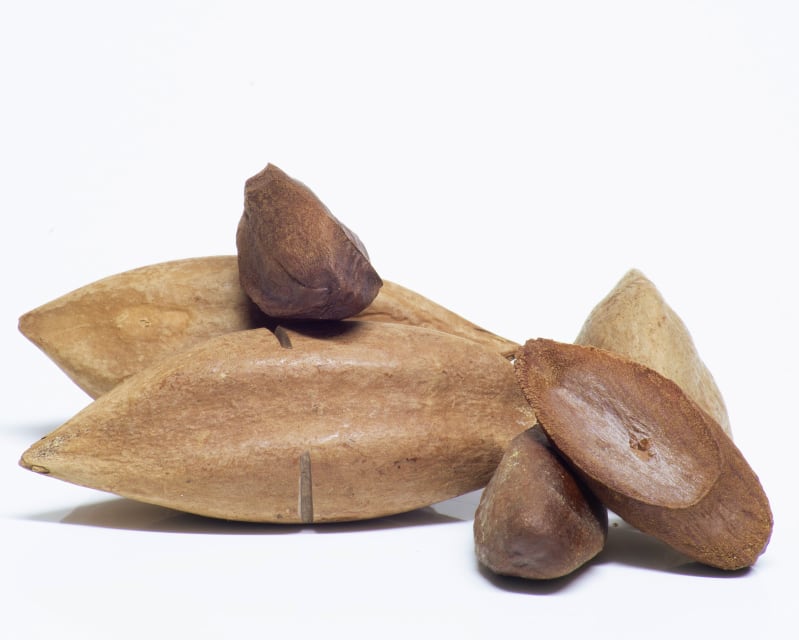

Pili nut is a reasonable source of supplementary protein, and is high in tryptophan, complementing the profile of yellow mustard.
For example, 10 tablespoons of yellow mustard (150g) and 2.2 tablespoons of pili nut (16g) make a complete amino acids profile. The entire range to create a complete protein are ratios of 1:0.11 to 1:0 for yellow mustard to pili nut by weight.
Full nutritional profile for pili nut
USDA Source: Nuts, pilinuts, dried
| Amino Acid | % of RDV [2] | Amount [18] |
Complete / Adequate |
|
| Protein |
|
14.8% | 7.4g | |
| Histidine |
|
35% | 0.22g | |
| Isoleucine |
|
34.7% | 0.3g | |
| Leucine |
|
30.9% | 0.58g | |
| Lysine |
|
26.7% | 0.46g | |
| Methionine |
|
20.8% | 0.18g | |
| Phenylalanine |
|
21.7% | 0.32g | |
| Threonine |
|
35.3% | 0.32g | |
| Tryptophan |
|
17.1% | 0.04g | |
| Valine |
|
36.9% | 0.4g |
Vegan 15. Papaya and Yellow Mustard


Low in protein, papaya is high in tryptophan, which is complementary to yellow mustard.
A ratio of 10 tablespoons of yellow mustard (150g) and 2.5 papaya (394g) creates a complete protein profile. The entire range to create a complete protein are ratios of 1:2.6 to 1:0.07 for yellow mustard to papaya by weight.
Full nutritional profile for papaya
USDA Source: Papayas, raw
| Amino Acid | % of RDV [2] | Amount [19] |
Complete / Adequate |
|
| Protein |
|
14.9% | 7.5g | |
| Histidine |
|
31.4% | 0.2g | |
| Isoleucine |
|
29.1% | 0.25g | |
| Leucine |
|
26.5% | 0.5g | |
| Lysine |
|
28.9% | 0.49g | |
| Methionine |
|
14.2% | 0.12g | |
| Phenylalanine |
|
18.6% | 0.28g | |
| Threonine |
|
32.6% | 0.29g | |
| Tryptophan |
|
17.3% | 0.04g | |
| Valine |
|
29.9% | 0.32g |
Vegan 16. Ginger and Yellow Mustard


Ginger is a reasonable source of supplementary protein, and is high in tryptophan, complementing the profile of yellow mustard.
For example, 10 tablespoons of yellow mustard (150g) and 3.9 tablespoons of ginger (21g) make a complete amino acids profile. The entire range to create a complete protein are ratios of 1:0.14 to 1:0.01 for yellow mustard to ginger by weight.
Full nutritional profile for ginger
USDA Source: Spices, ginger, ground
| Amino Acid | % of RDV [2] | Amount [20] |
Complete / Adequate |
|
| Protein |
|
15% | 7.5g | |
| Histidine |
|
34.9% | 0.22g | |
| Isoleucine |
|
33.7% | 0.29g | |
| Leucine |
|
28.8% | 0.54g | |
| Lysine |
|
26.1% | 0.45g | |
| Methionine |
|
15.4% | 0.13g | |
| Phenylalanine |
|
20.5% | 0.31g | |
| Threonine |
|
34.5% | 0.31g | |
| Tryptophan |
|
17.3% | 0.05g | |
| Valine |
|
34.2% | 0.37g |
Vegan 17. Portabella Mushroom and Yellow Mustard


A reasonable source of supplementary protein, portabella mushroom is high in tryptophan, which is complementary to yellow mustard.
A ratio of 10 tablespoons of yellow mustard (150g) and 1.1 cups of portabella mushroom (91g) creates a complete protein profile. The entire range to create a complete protein are ratios of 1:0.6 to 1:0.04 for yellow mustard to portabella mushroom by weight.
Full nutritional profile for portabella mushroom
USDA Source: Mushrooms, portabella, raw
| Amino Acid | % of RDV [2] | Amount [21] |
Complete / Adequate |
|
| Protein |
|
15.1% | 7.5g | |
| Histidine |
|
36.7% | 0.23g | |
| Isoleucine |
|
34.2% | 0.29g | |
| Leucine |
|
29.4% | 0.56g | |
| Lysine |
|
29.7% | 0.51g | |
| Methionine |
|
16.3% | 0.14g | |
| Phenylalanine |
|
20.8% | 0.31g | |
| Threonine |
|
38.1% | 0.34g | |
| Tryptophan |
|
17.5% | 0.05g | |
| Valine |
|
32.7% | 0.35g |
Vegan 18. Barley and Yellow Mustard


Barley is a reasonable source of supplementary protein, and is high in tryptophan, complementing the profile of yellow mustard.
For example, 10 tablespoons of yellow mustard (150g) and 1.6 tablespoons of barley (19g) make a complete amino acids profile. The entire range to create a complete protein are ratios of 1:0.13 to 1:0 for yellow mustard to barley by weight.
Full nutritional profile for barley
USDA Source: Barley, pearled, raw
| Amino Acid | % of RDV [2] | Amount [22] |
Complete / Adequate |
|
| Protein |
|
15.1% | 7.5g | |
| Histidine |
|
35.2% | 0.22g | |
| Isoleucine |
|
33.6% | 0.29g | |
| Leucine |
|
30.1% | 0.57g | |
| Lysine |
|
27.3% | 0.47g | |
| Methionine |
|
17.5% | 0.15g | |
| Phenylalanine |
|
23.4% | 0.35g | |
| Threonine |
|
35.1% | 0.32g | |
| Tryptophan |
|
17.5% | 0.05g | |
| Valine |
|
35% | 0.38g |
Vegan 19. Flaxseeds and Yellow Mustard


A reasonable source of supplementary protein, flaxseed is high in tryptophan, which is complementary to yellow mustard.
A ratio of 10 tablespoons of yellow mustard (150g) and 1.1 tablespoons of flaxseeds (11g) creates a complete protein profile. The entire range to create a complete protein are ratios of 1:0.07 to 1:7 for yellow mustard to flaxseed by weight.
Full nutritional profile for flaxseeds
USDA Source: Seeds, flaxseed
| Amino Acid | % of RDV [2] | Amount [23] |
Complete / Adequate |
|
| Protein |
|
15.2% | 7.6g | |
| Histidine |
|
36.5% | 0.23g | |
| Isoleucine |
|
36.8% | 0.32g | |
| Leucine |
|
30.3% | 0.57g | |
| Lysine |
|
28.7% | 0.49g | |
| Methionine |
|
17.9% | 0.15g | |
| Phenylalanine |
|
23.2% | 0.35g | |
| Threonine |
|
37.1% | 0.33g | |
| Tryptophan |
|
17.6% | 0.05g | |
| Valine |
|
37.1% | 0.4g |
Vegan 20. Spirulina and Yellow Mustard


Spirulina is a great source of protein, and is high in tryptophan, complementing the profile of yellow mustard.
For example, 10 tablespoons of yellow mustard (150g) and 0.5 tablespoon of spirulina (3g) make a complete amino acids profile. The entire range to create a complete protein are ratios of 1:0.02 to 1:2.3 for yellow mustard to spirulina by weight.
Full nutritional profile for spirulina
USDA Source: Seaweed, spirulina, dried
| Amino Acid | % of RDV [2] | Amount [24] |
Complete / Adequate |
|
| Protein |
|
15.2% | 7.6g | |
| Histidine |
|
34.3% | 0.22g | |
| Isoleucine |
|
38.4% | 0.33g | |
| Leucine |
|
32.3% | 0.61g | |
| Lysine |
|
29.3% | 0.5g | |
| Methionine |
|
17.9% | 0.15g | |
| Phenylalanine |
|
22.7% | 0.34g | |
| Threonine |
|
39.3% | 0.35g | |
| Tryptophan |
|
17.6% | 0.05g | |
| Valine |
|
37.5% | 0.41g |
Vegan 21. Mango and Yellow Mustard


Low in protein, mango is high in tryptophan, which is complementary to yellow mustard.
A ratio of 10 tablespoons of yellow mustard (150g) and 0.7 mango (251g) creates a complete protein profile. The entire range to create a complete protein are ratios of 1:1.7 to 1:0.02 for yellow mustard to mango by weight.
Full nutritional profile for mango
USDA Source: Mangos, raw
| Amino Acid | % of RDV [2] | Amount [25] |
Complete / Adequate |
|
| Protein |
|
15.3% | 7.7g | |
| Histidine |
|
35.9% | 0.23g | |
| Isoleucine |
|
33.9% | 0.29g | |
| Leucine |
|
29.8% | 0.56g | |
| Lysine |
|
32.8% | 0.56g | |
| Methionine |
|
15.6% | 0.13g | |
| Phenylalanine |
|
20.7% | 0.31g | |
| Threonine |
|
36.5% | 0.33g | |
| Tryptophan |
|
17.8% | 0.05g | |
| Valine |
|
36% | 0.39g |
Vegan 22. Cashews and Yellow Mustard
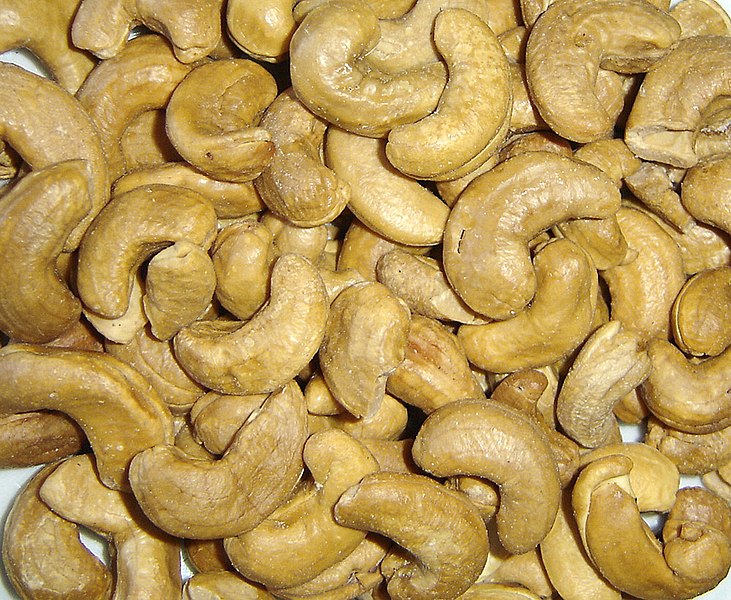

Cashew is a reasonable source of supplementary protein, and is high in tryptophan, complementing the profile of yellow mustard.
For example, 10 tablespoons of yellow mustard (150g) and 0.4 ounce of cashews (11g) make a complete amino acids profile. The entire range to create a complete protein are ratios of 1:0.08 to 1:8 for yellow mustard to cashew by weight.
Full nutritional profile for cashews
USDA Source: Nuts, cashew nuts, raw
| Amino Acid | % of RDV [2] | Amount [26] |
Complete / Adequate |
|
| Protein |
|
15.4% | 7.7g | |
| Histidine |
|
36.6% | 0.23g | |
| Isoleucine |
|
35.9% | 0.31g | |
| Leucine |
|
32.1% | 0.61g | |
| Lysine |
|
29.3% | 0.5g | |
| Methionine |
|
18.1% | 0.16g | |
| Phenylalanine |
|
23.5% | 0.35g | |
| Threonine |
|
36.6% | 0.33g | |
| Tryptophan |
|
17.8% | 0.05g | |
| Valine |
|
37.8% | 0.41g |
Vegan 23. Mint and Yellow Mustard
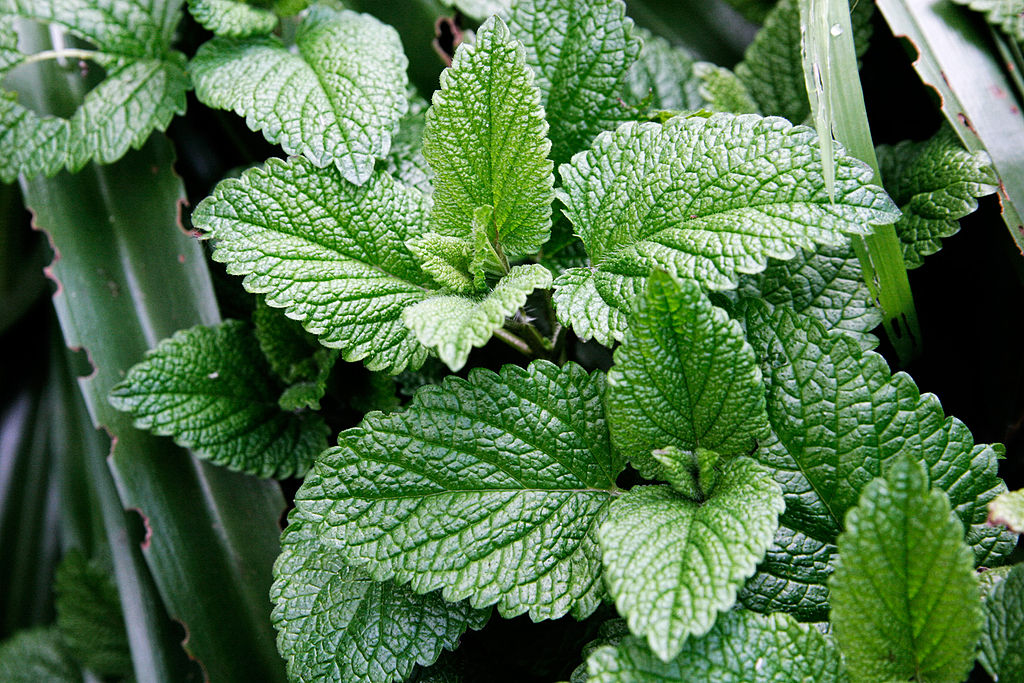

A reasonable source of supplementary protein, mint is high in tryptophan, which is complementary to yellow mustard.
A ratio of 10 tablespoons of yellow mustard (150g) and 2.2 cups of mint (57g) creates a complete protein profile. The entire range to create a complete protein are ratios of 1:0.38 to 1:0.05 for yellow mustard to mint by weight.
Full nutritional profile for mint
USDA Source: Peppermint, fresh
| Amino Acid | % of RDV [2] | Amount [27] |
Complete / Adequate |
|
| Protein |
|
15.5% | 7.8g | |
| Histidine |
|
35.1% | 0.22g | |
| Isoleucine |
|
35.7% | 0.31g | |
| Leucine |
|
31.7% | 0.6g | |
| Lysine |
|
28.5% | 0.49g | |
| Methionine |
|
16.8% | 0.14g | |
| Phenylalanine |
|
23.5% | 0.35g | |
| Threonine |
|
37.6% | 0.34g | |
| Tryptophan |
|
18% | 0.05g | |
| Valine |
|
36.2% | 0.39g |
Vegan 24. Rosemary and Yellow Mustard

Rosemary is a reasonable source of supplementary protein, and is high in tryptophan, complementing the profile of yellow mustard.
For example, 10 tablespoons of yellow mustard (150g) and 1.9 cups of rosemary (65g) make a complete amino acids profile. The entire range to create a complete protein are ratios of 1:0.44 to 1:0.8 for yellow mustard to rosemary by weight.
Full nutritional profile for rosemary
USDA Source: Rosemary, fresh
| Amino Acid | % of RDV [2] | Amount [28] |
Complete / Adequate |
|
| Protein |
|
15.6% | 7.8g | |
| Histidine |
|
35.2% | 0.22g | |
| Isoleucine |
|
35.8% | 0.31g | |
| Leucine |
|
31.8% | 0.6g | |
| Lysine |
|
28.6% | 0.49g | |
| Methionine |
|
16.8% | 0.14g | |
| Phenylalanine |
|
23.6% | 0.35g | |
| Threonine |
|
37.7% | 0.34g | |
| Tryptophan |
|
18% | 0.05g | |
| Valine |
|
36.2% | 0.39g |
Vegan 25. Grapes and Yellow Mustard
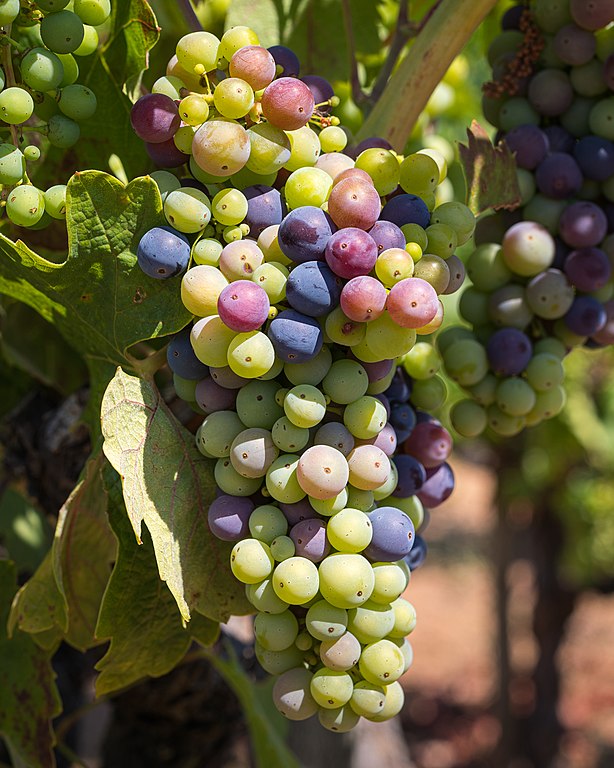

Low in protein, grape is high in tryptophan, which is complementary to yellow mustard.
A ratio of 10 tablespoons of yellow mustard (150g) and 2 cups of grapes (304g) creates a complete protein profile. The entire range to create a complete protein are ratios of 1:2 to 1:0.06 for yellow mustard to grape by weight.
Full nutritional profile for grapes
USDA Source: Grapes, red or green (European type, such as Thompson seedless), raw
| Amino Acid | % of RDV [2] | Amount [29] |
Complete / Adequate |
|
| Protein |
|
15.6% | 7.8g | |
| Histidine |
|
39% | 0.25g | |
| Isoleucine |
|
29.4% | 0.25g | |
| Leucine |
|
26.7% | 0.5g | |
| Lysine |
|
28% | 0.48g | |
| Methionine |
|
16.4% | 0.14g | |
| Phenylalanine |
|
20.1% | 0.3g | |
| Threonine |
|
35.3% | 0.32g | |
| Tryptophan |
|
18.1% | 0.05g | |
| Valine |
|
32.5% | 0.35g |
Vegan 26. Sunflower Seeds and Yellow Mustard


Sunflower seed is a reasonable source of supplementary protein, and is high in tryptophan, complementing the profile of yellow mustard.
For example, 10 tablespoons of yellow mustard (150g) and 4.6 teaspoons of sunflower seeds (13g) make a complete amino acids profile. The entire range to create a complete protein are ratios of 1:0.08 to 1:0.06 for yellow mustard to sunflower seed by weight.
Full nutritional profile for sunflower seeds
USDA Source: Seeds, sunflower seed kernels, toasted, without salt
| Amino Acid | % of RDV [2] | Amount [30] |
Complete / Adequate |
|
| Protein |
|
15.6% | 7.8g | |
| Histidine |
|
38% | 0.24g | |
| Isoleucine |
|
38.2% | 0.33g | |
| Leucine |
|
31.6% | 0.6g | |
| Lysine |
|
28.4% | 0.49g | |
| Methionine |
|
18.8% | 0.16g | |
| Phenylalanine |
|
23.7% | 0.35g | |
| Threonine |
|
37.8% | 0.34g | |
| Tryptophan |
|
18.1% | 0.05g | |
| Valine |
|
38% | 0.41g |
Vegan 27. Parsley and Yellow Mustard


A reasonable source of supplementary protein, parsley is high in tryptophan, which is complementary to yellow mustard.
A ratio of 10 tablespoons of yellow mustard (150g) and 1.2 cups of parsley (75g) creates a complete protein profile. The entire range to create a complete protein are ratios of 1:0.5 to 1:0.6 for yellow mustard to parsley by weight.
Full nutritional profile for parsley
USDA Source: Parsley, fresh
| Amino Acid | % of RDV [2] | Amount [31] |
Complete / Adequate |
|
| Protein |
|
15.6% | 7.8g | |
| Histidine |
|
35.5% | 0.22g | |
| Isoleucine |
|
35.7% | 0.31g | |
| Leucine |
|
31.2% | 0.59g | |
| Lysine |
|
31% | 0.53g | |
| Methionine |
|
16.9% | 0.15g | |
| Phenylalanine |
|
23.5% | 0.35g | |
| Threonine |
|
37.9% | 0.34g | |
| Tryptophan |
|
18.1% | 0.05g | |
| Valine |
|
38.1% | 0.41g |
Vegetarian 28. Half and Half and Yellow Mustard


Half and half is a reasonable source of supplementary protein, and is high in tryptophan, complementing the profile of yellow mustard.
For example, 10 tablespoons of yellow mustard (150g) and 7.5 teaspoons of half and half (38g) make a complete amino acids profile. The entire range to create a complete protein are ratios of 1:0.25 to 1:1.5 for yellow mustard to half and half by weight.
Full nutritional profile for half and half
USDA Source: Cream, fluid, half and half
| Amino Acid | % of RDV [2] | Amount [32] |
Complete / Adequate |
|
| Protein |
|
13.6% | 6.8g | |
| Histidine |
|
32.7% | 0.21g | |
| Isoleucine |
|
32.5% | 0.28g | |
| Leucine |
|
28.3% | 0.53g | |
| Lysine |
|
26.2% | 0.45g | |
| Methionine |
|
16.4% | 0.14g | |
| Phenylalanine |
|
19.8% | 0.3g | |
| Threonine |
|
33.6% | 0.3g | |
| Tryptophan |
|
15.7% | 0.04g | |
| Valine |
|
32.8% | 0.35g |
Vegetarian 29. Heavy Cream and Yellow Mustard


A reasonable source of supplementary protein, heavy cream is high in tryptophan, which is complementary to yellow mustard.
A ratio of 10 tablespoons of yellow mustard (150g) and 0.3 cup of heavy cream (42g) creates a complete protein profile. The entire range to create a complete protein are ratios of 1:0.28 to 1:0.09 for yellow mustard to heavy cream by weight.
Full nutritional profile for heavy cream
USDA Source: Cream, fluid, heavy whipping
| Amino Acid | % of RDV [2] | Amount [33] |
Complete / Adequate |
|
| Protein |
|
13.6% | 6.8g | |
| Histidine |
|
32.7% | 0.21g | |
| Isoleucine |
|
32.5% | 0.28g | |
| Leucine |
|
28.3% | 0.54g | |
| Lysine |
|
26.2% | 0.45g | |
| Methionine |
|
16.4% | 0.14g | |
| Phenylalanine |
|
19.8% | 0.3g | |
| Threonine |
|
33.7% | 0.3g | |
| Tryptophan |
|
15.8% | 0.04g | |
| Valine |
|
32.8% | 0.35g |
Vegetarian 30. Mayonnaise and Yellow Mustard
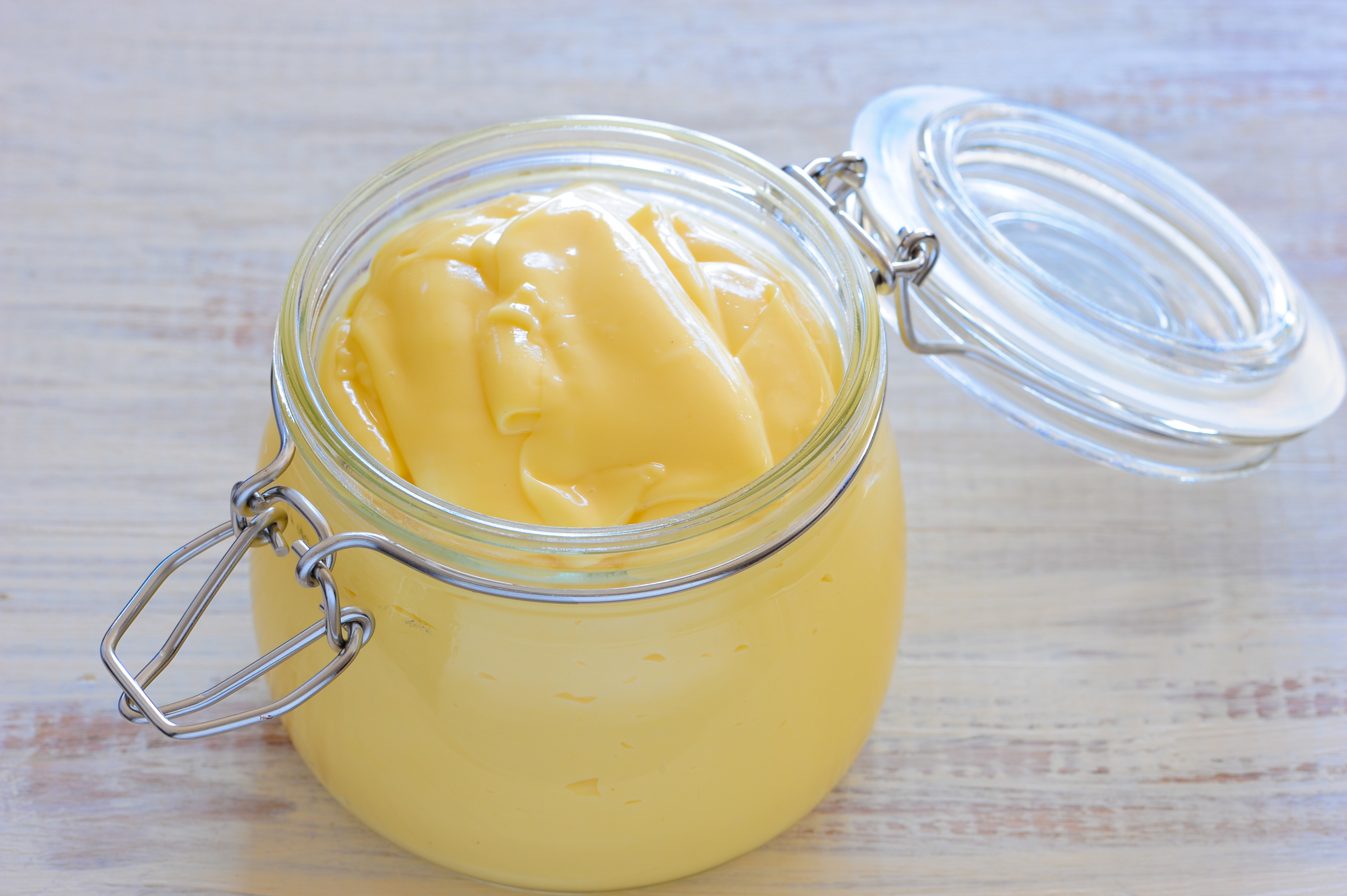

Mayonnaise is low in protein, and is high in tryptophan, complementing the profile of yellow mustard.
For example, 10 tablespoons of yellow mustard (150g) and 0.8 cup of mayonnaise (181g) make a complete amino acids profile. In fact, any ratio of more than 1.2:1 of mayonnaise to yellow mustard will be complete.
Full nutritional profile for mayonnaise
USDA Source: Salad dressing, mayonnaise, regular
| Amino Acid | % of RDV [2] | Amount [34] |
Complete / Adequate |
|
| Protein |
|
14.7% | 7.4g | |
| Histidine |
|
35.8% | 0.23g | |
| Isoleucine |
|
39.2% | 0.34g | |
| Leucine |
|
32.3% | 0.61g | |
| Lysine |
|
30.8% | 0.53g | |
| Methionine |
|
20.6% | 0.18g | |
| Phenylalanine |
|
23.1% | 0.34g | |
| Threonine |
|
38.9% | 0.35g | |
| Tryptophan |
|
17% | 0.04g | |
| Valine |
|
38.7% | 0.42g |
Vegetarian 31. Sour Cream and Yellow Mustard


A reasonable source of supplementary protein, sour cream is high in tryptophan, which is complementary to yellow mustard.
A ratio of 10 tablespoons of yellow mustard (150g) and 0.4 cup of sour cream (75g) creates a complete protein profile. In fact, any ratio of more than 0.5:1 of sour cream to yellow mustard will be complete.
Full nutritional profile for sour cream
USDA Source: Cream, sour, cultured
| Amino Acid | % of RDV [2] | Amount [35] |
Complete / Adequate |
|
| Protein |
|
14.9% | 7.4g | |
| Histidine |
|
39.2% | 0.25g | |
| Isoleucine |
|
39.6% | 0.34g | |
| Leucine |
|
35.9% | 0.68g | |
| Lysine |
|
35.1% | 0.6g | |
| Methionine |
|
20% | 0.17g | |
| Phenylalanine |
|
24.1% | 0.36g | |
| Threonine |
|
39.6% | 0.36g | |
| Tryptophan |
|
17.2% | 0.04g | |
| Valine |
|
39.7% | 0.43g |
